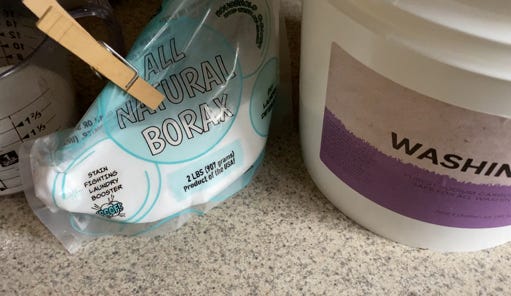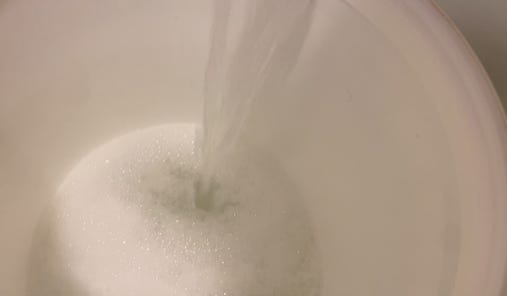Save money and avoid toxins with DIY laundry detergent recipe
Make 5 gallons of detergent with 4 ingredients.
My focus lately has been more-with-less. You may have noticed that from my plant guild post, which focused on boosting the productivity of the plants you have by siting them strategically. My sourdough pumpkin bread recipe was all about more nutrition with less sugar. Today it’s an abundant laundry detergent that requires less money and few ingredients.
Making my own laundry detergent costs me approximately $0.02 per load.
Sharing this laundry detergent recipe is partially self-serving. I make a batch of detergent every 6 months. Each time I make a batch I need to look the recipe up on my computer. Sharing it here on the blog will make it easy for me to pull it up any time on my phone.
I’ve adapted this recipe from one that a friend with many children gave me. The original recipe produces double the volume (10 gallons!) and has added fragrance with essential oils. As a family of 2, I don’t have the need for 10 gallons of detergent at a time. Managing a 5-gallon bucket is enough for me. If you’re concerned about the volume, you could:
Make half this recipe to produce a little more than 2 gallons.
Make the full 5-gallon bucket and move it to storage after making a quart-sized jar or two to keep by your laundry area, or to take with you when you travel. I opt to use my homemade detergent when I’m home and I use dry laundry sheets from Earths Laundry when I travel.
Make a full batch and split it with a friend or family.
I buy the ingredients in bulk. Except for the bar of soap, I also use the other ingredients in making my own dishwasher detergent. One of the many benefits of DIY laundry detergent is that you can choose the ingredients, which helps avoid the synthetic fillers, pthalates, and parabens associated with hormone and endocrine disruption.
With that said, the recipe I use and share isn’t perfect. On the Good-Better-Best scale, I think it’s a firm Better. For instance, the Environmental Working Group calls out borax as a hormone disruptor and an eye and respiratory irritant. When making this recipe, you might prefer to wear a face covering or eye protection, particularly when working with borax in its dry form. On the flip side, the details about borax concerns are generally related to high, chronic exposure. This detergent recipe has ¼ cup of borax to 5 gallons of water. With ½ cup of detergent or less per laundry load, the ratio of borax per load is miniscule.
Benefits of making your own laundry detergent
Laundry detergent bottles are made with HDPE (high-density polyethylene), a plastic that takes so long to break down that many sources refer to as a plastic that "never breaks down." Think of how many laundry detergent bottles you’ve gone through in your life. All of those bottles are still out there. Somewhere.
Reduce your exposure to toxins. A cocktail of chemicals in detergents are associated with fertility issues, fetal developmental effects, metabolic concerns, asthma, diabetes, irregular menstrual cycles, and a number of hormone-related conditions. According to Safer Choice-certified detergent maker ECOS, another critical ingredient to watch for is 1,4-dioxane, “a known human carcinogen and neurotoxin.”
Reduce environmental exposure to toxins. Many detergents have phosphates, which contribute to algae blooms. Imbalances in waterways can harm wildlife, reducing oxygen in the water and physically harming fish gills and the delicate skins of amphibians.
Lower environmental impact. Making in bulk means less packaging in landfills and fewer trips to the store or home deliveries. Laundry detergent bottles are made with HDPE (high-density polyethylene), a plastic that takes so long to break down that many sources refer to as a plastic that "never breaks down." Think of how many laundry detergent bottles you’ve gone through in your life. All of those bottles are still out there. Somewhere.
Save money. In an earlier post about DIY home cleaning supplies, I share the bulk cost of this recipe compared to the cost of conventional detergent. Making my own laundry detergent costs me approximately $0.02 per load, which is less than $9 per year. I save approximately $39 annually by not buying industrial detergent.
3 wallet-friendly DIY home cleaning supplies
One of the big themes of this blog is nutrient-dense food. If we’re taking steps to invest more in the quality of our food and improve our health, we could be canceling out those efforts by wasting money on household products that introduce toxins. Money saved from making your own cleaning supplies could be reinvested in health-focused foods and efforts.
DIY laundry detergent recipe
This recipe makes 5 gallons. Remember: As stated earlier, you might consider wearing eye or respiratory protection when handling borax. Borax can also be absorbed through the skin, so consider wearing gloves or use tools that avoid skin exposure.
½ cup washing soda
¼ cup borax
½ bar of soap, approximately 2.5 ounces (Some folks recommend Fels Naptha. I buy in bulk from an Etsy seller that makes their own unscented natural laundry soap bars. A few years ago I bought 4 5-oz bars for $27, including shipping, and this will last me 8 years.)
Optional: essential oils and white vinegar
Bring 2 quarts of water to a boil in a large pot.
While the water heats up, combine the washing soda and borax in a bowl.
Grate the bar of soap into a separate bowl.
As soon as the water comes to a boil, turn off the heat and add the grated soap. Stir until completely dissolved.
Pour in the washing soda/borax blend and keep stirring for 30 seconds.
Pour the pot into a 5-gallon bucket. Fill the rest of the bucket with hot water (from a bathtub tap works) and keep stirring until full.
Allow the mixture to cool uncovered for about an hour. Then cover and let sit for 12 hours before using or separating into smaller containers.
Use ¼ cup to ½ cup detergent per laundry load, depending on load size. For clothes that need a boost (like gym clothes), add a few drops of your favorite essential oil to the detergent when you add it to the laundry machine, or add a cup of white vinegar to the load.
If you’re just starting to make your own cleaning products, this is a good one to start with because it takes only about 15 minutes and makes a high volume of a product you’ll use for a long time. I’ve picked products one-by-one to make or replace and I’m now down to shampoo and conditioner. I had found a brand that I liked, but their product changed and became a hassle to use. If there’s a toxin-free shampoo or conditioner you recommend, please comment and let me know.






